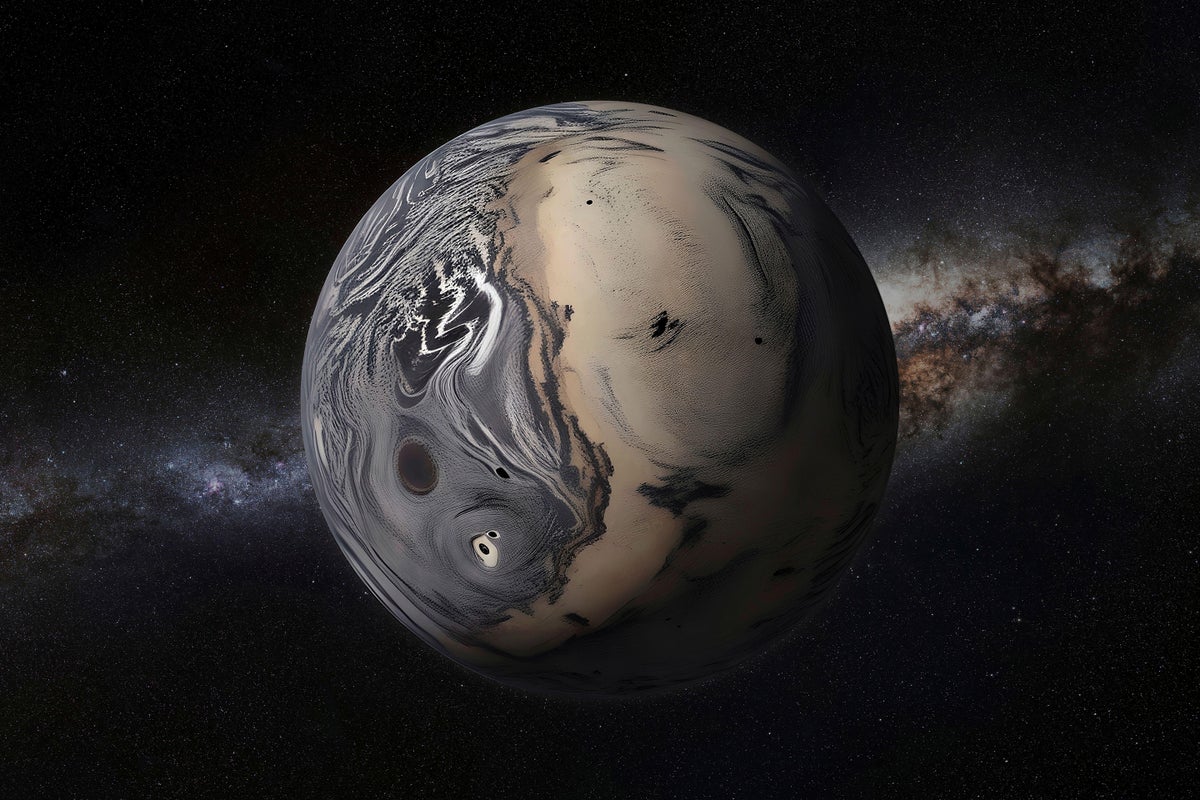
As J.R.R. Tolkien wrote in The Fellowship of the Ring, “Not all those who wander are lost.” But in the case of planets, it’s possible that most of them are.
Rogue planets—planets that are adrift in space, unmoored from any star—have been a topic of science fiction for a long time; both Star Trek and Space:1999 featured them in episodes. But they actually do exist in real life. Astronomers, who sometimes like to kill fun, call these worlds free-floating planets, which is not nearly as cool a term.
Still, these interstellar drifters are pretty interesting. Most have been found via microlensing: their gravity acts as a lens that boosts the light of a background star in a measurable way. These worlds tend to be so small, dark and far away that they’re otherwise invisible to us. Some, similar to Jupiter in mass, have been glimpsed in images; these likely formed directly from the gas and dust in a nebula, much as a star does, and may have thus always lacked a home star. But others, much lower in mass, are expected to have formed around a star only to subsequently be ejected from their planetary system. Now these outcasts slip silent and cold through the sunless spaces between the stars.
On supporting science journalism
If you’re enjoying this article, consider supporting our award-winning journalism by subscribing. By purchasing a subscription you are helping to ensure the future of impactful stories about the discoveries and ideas shaping our world today.
How are they ejected? While there are a handful of possible methods, the most common is likely via interactions with another planet around its host star. We know that planets don’t just orbit their star in the same place forever. Over time, planetary orbits can shift because of the combined gravitational influences of other planets in a system. If two planets get too close to each other, the interaction can cause one (usually the less massive of the two) to gain a lot of orbital energy, causing it to be flung out of the system.
A team of astronomers at the Technion–Israel Institute of Technology examined this question and presented its results in a new preprint paper awaiting publication in the Astrophysical Journal. The researchers ran what are called N-body simulations, computer models that use the equations of gravity and motion to simulate the positions and orbits of planets over time. By running repeatedly while varying the input parameters, these models can give statistical estimates for how often certain events such as ejections can occur.
The team ran simulations of 100 different planetary systems, each comprised of anywhere between three to 10 planets that, much like the worlds of our own solar system, were on near-circular coplanar orbits around a sunlike star. They then let the equations run for a billion simulated years.
What they found was that encounters are quite common! There are lots of interactions between planets as some get nudged into elongated orbits that can cause one world to essentially cross the path of another. What can happen then is a direct collision—that is, an actual colossal impact that can shatter the planets or at least do extreme damage. That outcome is more common than you might think, occurring, on average, 0.4 time per planetary system (so, in 100 systems, you’d expect to see about 40 collisions). They tend to happen early on; most occur within a million years of a simulation’s start.
But ejections are even more common: the team determined that on average as many as 3.5 planets are ejected per system after a billion years, and most ejections happen within the first 100 million years. That result surprised me; given that there were only three to 10 planets per system in the simulations, I wouldn’t have thought there would be so many ejections. But this is exactly why scientists do these sorts of calculations; our expectations can be biased, whereas the math and physics isn’t.
The researchers also found that a planet at any given location was as likely as any other to be ejected over the course of their simulations, so neither inner nor outer planets could be considered safe, although an innermost planet tends to be ejected first. The ejected planets usually leave the system at a relatively leisurely velocity, about two to six kilometers per second. Earth orbits the sun at more than 30 km/sec, so these ejection speeds are fairly low.
Very interestingly, they found that systems with fewer planets tend to exit their “ejection” phase after about 100 million years, but systems with 10 planets are still unstable even after a billion years. They also found that these more bountiful systems actually eject the majority of their planets, losing 70 percent after a billion years. Most of the ones ejected are lower-mass, as expected.
The obvious question is, well, what about us, then? Our solar system has eight major planets and has been around for more than four billion years. If a system can be unstable after a billion years, are we safely past that deadline? Why are we still around?
We could just be lucky. That’s possible. The results the team published are averages over many simulations, so some systems lose more planets than others. It could be that the simulations the researchers ran are incomplete and that more parameters need to be included. It’s also possible that our solar system beat the odds for long enough to become stable and that, from here on out, we’ll be fine.
The team also found that to match the number of ejected free-floating planets detected by astronomers, every star in the galaxy needs to form five to 10 planets on average. That’s a lot but not out of the question. Some stars may have lots of planets, and some may only form a few (or none). TRAPPIST-1, for example, is a tiny, low-mass red dwarf star, and it has at least seven Earth-sized planets! Red dwarfs are the most common kind of star in the universe, so they alone could possibly explain all the low-mass ejected planets we see. Stars like the sun might eject many planets as well, but they only account for about 10 percent of all stars, so that’s a molehill compared with the red dwarfs’ mountain.
This work is still preliminary, and there’s a lot left to explore. But the numbers do match observations pretty well, giving us good reasons to suspect there are more free-floating planets out there in the galaxy than ones orbiting stars.
How many of them once circled our own sun? How many planetary siblings have we lost? None? One? Four? We’ll likely never know; our solar system’s 4.6-billion-year history offers a long time for shedding worlds into the Milky Way. But there very well could be galactic nomads wandering in deep space that began their endless journey right here around our sun. If so, they have a lot of company.
